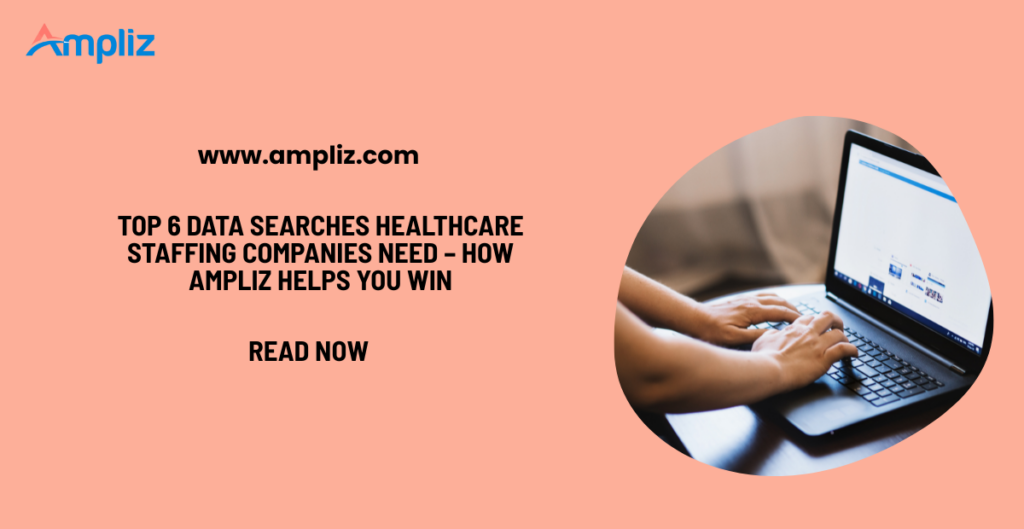In today’s fast-paced healthcare environment, staffing companies are under pressure like never before. Physician shortages, rising demand, burnout, and the evolving structure of care delivery mean that healthcare staffing firms must be more strategic, more data-driven, and more nimble than ever.
At Ampliz, we believe that the right data searches can transform the way a staffing firm sources candidates, wins new contracts, and stays ahead of shifts in the market. Below are six essential data searches that healthcare staffing companies should be leveraging—and how Ampliz’s data tools and services make them far more effective.
1. Physician Candidates by Specialty & Subspecialty
One of the most fundamental needs for a staffing company is identifying physicians who match a required specialty (or subspecialty), with the right mix of experience, procedural volume, location, clinical activity, and credentials.
Key Search Criteria:
- Primary specialty and subspecialty
- Clinical activity level (number of procedures, patient volume)
- Geographic location / region
- Credentials, medical license, board certifications
- Years of experience / hospital affiliations
- Demographics, if relevant (age, gender)
Why It Matters:
- Filling niche or high-skill roles (e.g. cardiac surgeons, interventional radiologists) depends on knowing who is active and qualified.
- Faster matching reduces time-to-fill, reduces gaps in service, and improves client satisfaction.
How Ampliz Helps:
- Comprehensive physician databases enriched with credential, specialty, license, and affiliation data.
- Filters for procedural volumes or case loads so you can see who is actively practicing.
- Geo-filtering to find physicians in or willing to move to specific regions.
- Real-time or regularly updated data so you don’t waste time on retired, inactive, or unlicensed physicians.
2. Executive & Decision-Maker Contacts in Hospitals & Health Systems
Securing contracts or partnerships with hospitals often depends on reaching the right people e.g. Chief Medical Officers, Heads of Departments, Directors of Nurse Staffing, or CIOs (if you offer specialized staffing or tech services).
What to Search For:
- Organizational charts: who holds what position
- Contact information: phone, email, sometimes social profiles
- Affiliation history: past roles, board memberships, movement between hospitals
- Decision-making power: who approves contracts, budget holders
Behind the Power:
- Engaging these decision-makers early can speed up negotiations, clarify needs, and secure larger, longer-term contracts.
- When hospital or health system leadership changes (e.g. mergers, acquisitions), opportunities and priorities shift. Being aware of these changes allows staffing firms to adapt and re-engage appropriately.
How Ampliz Helps:
- Executive contact databases that are verified and updated.
- Alerts on leadership changes in target hospitals or systems.
- Profiles showing background, affiliations, previous organizations to give context to outreach.
3. Hospital & Health System Performance, Trends & Market Activity
To target prospective clients (hospitals, ASCs, clinics) intelligently, staffing firms need to know which institutions are growing, under stress, undergoing change, or likely in need of external staffing resources.
Data Points to Monitor:
- Financial performance and metrics (profit/loss, margins)
- Clinical performance (readmission rates, patient satisfaction, quality indicators)
- Operational changes: expansions, new service lines, technology upgrades, facility renovations
- Trends like mergers, acquisitions, closures
- Regulatory or policy shifts impacting funding
Why This is Important:
- Hospitals under pressure (financial or operational) may look to outsource more staffing or engage temp/contract labor.
- Knowledge of market expansion (new wings, technology installs) helps staffing firms anticipate demand and position themselves accordingly.
- Being aware of competitor activity and industry shifts ensures you can proactively approach new clients rather than reacting.
How Ampliz Helps:
- Facility profiles with up-to-date performance and financial metrics.
- Data on market trends, merger & acquisition activity, expansions.
- Facility technology and infrastructure details to understand capabilities, potential stress points, or staffing gaps.
4. Requests for Proposals (RFPs) & Projected Staffing Needs
Often, hospitals and systems issue RFPs or otherwise signal talent/staffing needs when they undertake projects such as expansions, technology overhauls, or regulatory compliance initiatives.
What to Search / Track:
- Open RFPs related to staffing, clinical services, or facility management
- Planned new service lines, renovations, or facility changes that require extra staffing
- Declared staffing shortages or regulatory-driven compliance gaps
Why It Helps:
- Gives staffing firms early insight into upcoming opportunities.
- Allows time to prepare proposals, assemble candidate pools, and engage the right executives.
- Helps in strategic allocation of resources—anticipating demand rather than scrambling.
How Ampliz Helps:
- RFP tracking tools and alerts for relevant opportunities.
- Market intelligence reports that identify where hospitals are expanding, investing in new equipment or services.
- Data feeds that highlight regulatory or compliance events that may trigger staffing needs.
5. Claims & Treatment Data for Credentialing & Quality Assurance
Using medical (payer) claims and prescription claims data helps in validating a physician’s practice activity, experience, and procedural competence.
What to Look For:
- Claims history: types of services billed, procedural volume, specialty match
- Prescription or drug utilization data where relevant
- Patient population served, payer mix, geographic exposure
- Any red flags (licensure issues, malpractice history, etc.)
Why This is Critical:
- Credentialing is a legally and ethically necessary step. Staffing companies must ensure a candidate can practice in the role.
- Claims data provides a more objective measure of what a physician is actually doing (versus what is on paper).
- Quality assurance: firms placing candidates want to know not just “can they do it” but “do they currently do it, safely and reliably.”
How Ampliz Helps:
- Access to claims datasets (all-payer claims, prescription claims) with relevant filters (by year, geography, specialty).
- Tools to cross-reference claims with license, board certifications, affiliations to verify credentials.
- Analytics to spot anomalies, trends, or gaps in practice that might matter for clients or compliance.
6. Outpatient Facilities & Ambulatory Surgery Centers (ASCs)
Patient preferences, cost pressures, and regulatory shifts are pushing more care into ambulatory settings. ASCs and other outpatient facilities are growing in importance, and they carry unique staffing needs.
What Searches Are Useful:
- Location, specialties offered, affiliations of ASCs
- Technology installed and quality metrics in ambulatory settings
- Volume of procedures, clinical activity, patient outcomes
- Regulatory status, accreditation, recent upgrades or expansions
Why It Matters:
- These settings have different staffing models (often leaner, high throughput) and may need specialized staff (e.g. ambulatory anesthesiologists, minimal invasive surgeons, specialized nursing).
- ASCs may be earlier in terms of adopting innovations, which creates opportunity for staffing firms with unique value propositions.
- Understanding which ASCs are growing or updating gives early signals of demand.
How Ampliz Helps:
- Databases of outpatient facilities & ASCs with detailed profiles: services, performance, affiliations.
- Search tools for tech installs and quality metrics (e.g., accreditation, outcome metrics).
- News and alerts about facility expansions, upgrades or other events that tend to precede staffing needs.
Bonus: Contract Labor Spend Analytics
While not always treated as a “search” per se, understanding how much hospitals are spending on contract labor (temporary / locum / agency staff) can be hugely strategic. It tells you who is already depending on staffing firms, where budgets exist, and where cost pressures are highest.
What to Gather:
- Data on contract labor spend as reported in financial statements, cost reports, or reimbursement filings
- Details on which departments or service lines rely heavily on contract labor
- Trends over time: is contract labor spend rising? Or are hospitals pushing to reduce it?
Why It’s Valuable:
- Helps you identify hospitals more likely to outsource labor rather than hire full-time.
- Informs your sales pitch: if a hospital is spending heavily, you might propose cost-efficient staffing solutions, or public-private partnerships.
- Helps in segmentation: some hospitals may have minimal contract spend; others make it a core part of operations.
How Ampliz Helps:
- Financial and cost-report datasets with contract labor line items or equivalent metrics.
- Analytics to compare contract spend across hospitals, regions, and chains.
- Tools to track how contract spend is changing over time, or what pressures (policy, reimbursement) are affecting it.
Bringing It All Together: How Ampliz Enables Smarter Decisions
These data searches aren’t isolated; the true value comes when combining them to inform strategy:
- Intelligent candidate sourcing: Use physician specialty + claims + credentials so only top, active candidates are sourced.
- Strategic sales targeting: Use hospital performance + executive contacts + contract labor spend + RFP tracking to prioritize outreach.
- Operational readiness: Be prepared with candidate pools, compliance documentation, and forecasting so you respond fast when opportunities appear.
With Ampliz, your firm gets:
- Clean, verified, regularly updated data
- Flexible search and filter tools to combine criteria
- Alerts and insights so you don’t miss emerging opportunities
- Analytics to see patterns: e.g. which specialties are most in demand in particular regions; what’s happening with contract labor; where ASCs are growing etc.
Case Example (Hypothetical)
To illustrate how this might work in practice, consider this scenario:
A hospitals network in a Midwestern U.S. state has announced plans to open a new cardiac catheterization lab and upgrade its EHR system. At the same time, they are hiring a Chief of Cardiology and bringing on board additional interventionalists.
A staffing firm using Ampliz notices:
- The hospital’s “Technology install” tab shows planned investment in cardiology-related equipment.
- Their financials show some margin pressure, making them likely candidates to lean on contract staffing during ramp up.
- The leadership contact change has occurred: new CMO is in place, with interests in expanding cardiac services.
- By searching for cardiologists with interventional subspecialties in neighboring states (willing to relocate or remote consulting), and checking their claims data, they find prospects.
- They also track RFPs and announcements from the hospital to get ahead of procurement and staffing contracts.
Outcome: The staffing firm secures both contract work (to help with ramp up) and long-term physician placements faster than competitors who respond only after recruitment is underway.
Best Practices & Tips
To make the most of these data searches, staffing companies should consider:
- Regular updates & data hygiene — Outdated physician credentials, inactive providers, leadership changes etc. can waste time.
- Combine different data sources — Don’t rely solely on specialty lists. Combine with claims, hospital data, facility performance, and RFP activity.
- Automated alerts — Use tools that notify you when hospitals announce leadership shifts, new service line launches, or regulatory changes.
- Segmentation & prioritization — Not every opportunity is equal. Segment hospitals by size, financial health, previous contract spend, or growth potential. Target the realistic ones first.
- Quality & compliance tracking — Always check for credentials, malpractice, licensing issues. Claims data is useful, but combined with other verification, ensures less risk.
- Local/regional nuance — Healthcare is often regulated and delivered differently across states or countries. Stay aware of regional variations in credentialing, licensing, facility behavior etc.
Conclusion
The healthcare staffing market is changing fast. To succeed, firms need to move beyond intuition and generic candidate directories. What’s needed is precise, multi-dimensional data: who is active, where, with what capabilities; which hospitals are growing, under what pressures; and which opportunities are opening up via RFPs, facility expansion, or shifts in spending.
Ampliz empowers you with exactly these tools. With deep physician data, hospital performance metrics, executive contacts, claims analytics, outpatient facility profiles and contract labor insights, you can:
- Source better candidates
- Approach the right clients
- Anticipate demand
- Move faster than competitors
If you’re ready to work smarter, not just harder, contact us at Ampliz to explore a demo or trial. Let’s turn data into your competitive edge.



